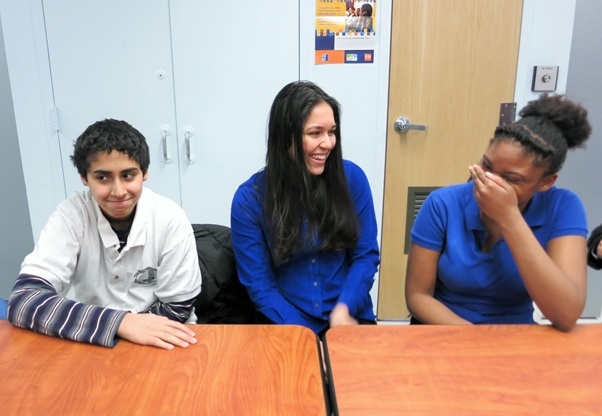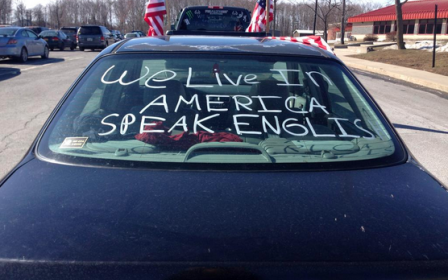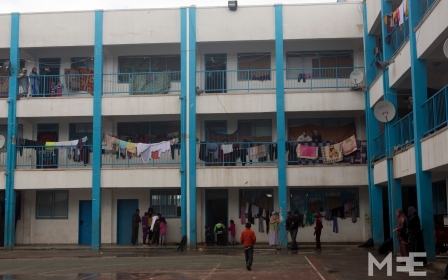'Madrassa in Brooklyn' turns the page on controversy

NEW YORK - It has taken years to shake off the label “Madrassa in Brooklyn”, but New York principal Winston Hamann says he has bid farewell to a controversy that has dogged his school since its first pupils, Arab-Americans and others, walked through the doors in September 2007.
Back then, placard-waving protestors thronged in the streets outside Khalil Gibran International Academy (KGIA) amid fears that a dual-language, Arabic and English curriculum would also see children schooled in radical Islamist ideology.
Nowadays, it looks like any another high school – with a few more headscarves than usual. But while enrolment is picking up, some of the school’s original backers say it has ultimately failed to realise a goal of becoming a beacon for Arabic language and culture.
“It was very challenging at the beginning. It was inundated with bigotry,” Hamann, who took over in 2011 as the school’s fifth principal in its first five years, told Middle East Eye, during a visit to the building in downtown Brooklyn.
“When I arrived, the goal was to increase enrolment. Nowadays, enrolment has tripled … and what’s amazing is the fact that we have created a culture of respect and awareness of our diversity and getting along together.”
More than half of the school’s 180 boys and girls are African-American; a third are Arab-American, most of Yemeni origin. The rest of the school, which takes its name from a trailblazing Lebanese Christian poet, is made up of Asians, Latinos and others.
With less than 40 percent of students coming from Arabic-speaking families, and problems hiring Arabic-speaking teachers, the school never won dual-language status, where key subjects are taught in Arabic. Instead, Arabic is taught separately as a foreign language.
In one classroom, pupils gazed at a whiteboard of Arabic script words for buttermilk, chick peas and other Levantine grocery items. Otherwise, the strip lighting, plastic chairs and dingy corridors are dispiritingly reminiscent of any other school.
“I wanted to be born in Yemen so I could learn Arabic there,” Mohamed Mohamed, a 15-year-old Yemeni-American student who plans to become a doctor, told MEE. “I should be able to speak fluent Arabic before the end of high school.”
Back in Mohamed’s house, his parents follow news from Yemen – where a spiralling civil war has drawn in Saudi Arabia and others launching air strikes – amid concerns over relatives in Aden and across the south of the turbulent country.
Discussing Middle East politics is acceptable at home, but Yemen’s collapse, the rise of the Islamic State (IS) and other crises in the region are seldom mentioned in classrooms or on the small tarmac playground outside, he added.
“My mum talks to me about it at home. But there’s not so much debating about politics, especially in the school,” he said. “When you talk about it with the kids, everyone has their own different opinion, because they get their opinion from their families.”
While teachers in some European schools – particularly those serving Arab and Muslim communities – express worries about youngsters being radicalised online and joining extremists overseas, such concerns are less prevalent in the US.
According to Nazir Afzal, a UK prosecutor, head-teachers of London schools told him they were “scared” that pupils could flee and join IS, the sectarian Sunni Muslim militia that controls swathes of Syria and Iraq, during the Easter holidays.
Fears were heightened in February, when three schoolgirls from Bethnal Green Academy in east London – Shamima Begum, Amira Abase and Kadiza Sultana – disappeared from their homes and flew to Turkey. They are believed to have crossed into Syria and joined IS.
There have been no such problems in Brooklyn, where students’ access to Facebook and other social networks is monitored, said Hamann. Teachers quickly hear about depression, self-harming and other warning signs that pupils may post online.
“Every student has an email and does lots of their work online, but the Department of Education is very strong in providing filters,” he told MEE. “The Chrome notebooks have a vault that does not allow them to get out of the domain or share information out of the domain.”
While KGIA’s controversy has subsided, students are conscious of a wariness over headscarves, the Arabic language and aspects of Muslim culture that have lingered in the US since the 9/11 attacks on New York and Washington.
Another school in New York State came under the spotlight in March after receiving multiple complaints for allowing a student to recite the US Pledge of Allegiance in Arabic during a week of activities focussed on foreign languages.
Pine Bush High School’s superintendent, Joan Carbone, said she received complaints from Jewish parents and residents who had lost family members during America’s 14-year war in Afghanistan. School officials apologized.
“In terms of the Pledge of Allegiance, I’m very respectful about that,” Hamann told MEE. “But this is a high school, and we don’t do the pledge of allegiance every morning.”
According to KGIA’s counsellor, Gina Shedid, an Egyptian-American, students are less troubled by stereotypes about Muslims and Arab-Americans than more “typical teenage issues” such as dating and working weekend jobs.
“They don’t have a lot of complaints about what happens outside school. They’re used to it, little comments, that they don’t bring it up,” she told MEE. “It can be problematic for girls; they can be concerned about reputations and balancing Yemeni and Arab values against American values.”
The school was conceived as a dual-language hub for Brooklyn’s Arab-American community, teaching grades 6-12, with pupils aged from 11-18 years, but hit a storm of controversy even before it opened for its initial intake of 60 pupils.
Founding principal Debbie Almontaser, a headscarf-wearing American of Yemeni heritage, resigned in August 2007 after she gave an interview with the New York Post, a right-wing tabloid newspaper, which connected her with religious extremism.
Almontaser defended the phrase “Intifada NYC” being used on T-shirts produced by a Muslim women’s group she was affiliated with, saying it meant “shaking off repression”. The newspaper dubbed her the “Intifada Principal”.
A pressure group called “Stop the Madrassa” accused the school of having ties to the Muslim Brotherhood. Enrolment dropped in its second year, maths exam pass rates were low and, in 2008, it had one of the worst rates of suspension in the city.
“We were called militants in sheep’s clothing and accused of converting schoolchildren,” Lena Alhusseini, director of the Arab-American Family Support Center, which helped set up the school, told MEE. “But we didn’t crumble under the pressure of being called a madrassa.
“We stuck with it, it’s been successful ever since and we feel we’ve done our job.”
Others disagree. Donna Nevel, a psychologist who writes about Islamophobia and other social issues in Brooklyn, blames the Department of Education (DOE) for failing to support Almontaser and caving in to a right-wing smear campaign.
“As a result of the DOE’s actions, beginning with its capitulation to an anti-Muslim, anti-Arab campaign and forcing the founding principal, Almontaser, to resign, the school does not resemble the dual Arabic-English language school that was envisioned, which would have been an extremely valuable addition to New York’s public school system,” she told MEE.
Harry Hartfield, a DOE spokesman, said he could not respond to criticism because the controversy occurred too long ago.
For Linda Sarsour, director of the Arab American Association of New York, abandoning the dual-language project and shrinking back the school to only grades 9-12 means students will graduate without proficiency in Arabic. Given US links to the region, Arabic-speaking skills would help youngsters from poor backgrounds get jobs in business and diplomacy, she added.
“They were supposed to have a robust Arabic dual-language programme with at least six hours of instruction a week. It would have been the first dual-language school in the country. Unfortunately, it didn’t fulfil that,” she told MEE.
“That’s a big loss for the opportunity that kids would have gotten from being bilingual in Arabic.”
Back at school, principal Hamann strolls the corridors, pointing excitedly at students’ artworks and a newly-refurbished cafeteria. In his office are snacks for the guests: baklava served with cookies and coffee from Dunkin’ Donuts. It could be a metaphor for the school.
KGIA had a tough start, but it is getting better and students learn a bit of Arabic, he said.
“It’s not about being idealistic. I see the possibilities because I experience them. I see them sharing, I see them holding hands. We have created a culture of collaboration and respect, no matter where you come from,” he told MEE.
New MEE newsletter: Jerusalem Dispatch
Sign up to get the latest insights and analysis on Israel-Palestine, alongside Turkey Unpacked and other MEE newsletters
Middle East Eye delivers independent and unrivalled coverage and analysis of the Middle East, North Africa and beyond. To learn more about republishing this content and the associated fees, please fill out this form. More about MEE can be found here.






